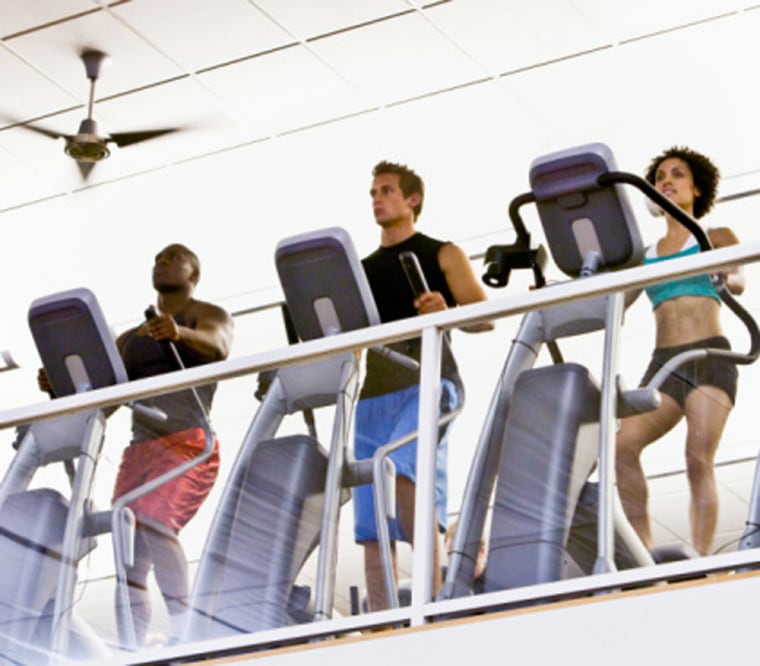Does it matter what sequence you do your exercises in? Which workouts are best for people with a bum knee or a bad back? Smart Fitness answers your workout queries.
Have an exercise question? To e-mail us, click here. We’ll post select answers in future columns.
Q: Are there certain exercises you should do before others?
A: There are no hard and fast rules about how to structure workouts.
The old-school thinking was that the first step is always to stretch out. But fitness experts now say there's no evidence that stretching before a workout or sports competition reduces injuries, and it may even impair performance.
It is recommended, though, that you warm up first, by doing a lighter version of whatever activity you've got planned, and to cool down at the end of a workout.
Another bit of traditional advice is to do cardiovascular exercise such as running, biking or aerobics before hitting the weights. But some trainers now recommend the reverse, because you may be too tired from all that cardio to most effectively pump iron.
Ultimately, what's best for you really depends on your fitness goals, says exercise physiologist Robert Otto, director of the human performance laboratory at Adelphi University in Garden City, N.Y.
You'll be strongest and get the most bang for your buck from whichever activity you do first, he says.
"If you're more interested in the results of weight training, then you should probably do that before fatiguing from aerobic activity," he says. And if your main aim is to boost your heart health or lose weight, then do the cardio first.
"It is more about your personal preference and performance," adds Jay Blahnik, a personal trainer in Laguna Beach, Calif. "Sort of like it is between morning and evening workouts."
In terms of the specifics of your weight workouts, however, sequence does matter. Experts recommend working the larger muscle groups, such as those of the thighs, chest and back, before the smaller ones, such as those of the shoulders, arms and abdomen.
That's mainly for safety reasons. You'll be stronger at the beginning of your weight workout, so it's best to work the bigger muscles first to avoid injury when you're tired, says Otto.
That said, he recommends mixing some things up. So don't always start with the same large muscle group, and don't always do the exact same exercises for each one. This will allow you to get better results by challenging the muscles in different ways.
"Plus, it avoids boredom," he says.
Q: What types of exercise are recommended for someone with a knee problem? Weight-bearing exercise worsens the problem and causes intense pain.
A: Definitely don't exercise through the pain, says Dr. Frederick Azar, a professor of orthopedic surgery at the University of Tennessee in Memphis and a spokesperson for the American Academy of Orthopaedic Surgeons.
"Certain exercises can exacerbate a problem," he says.
If you aren't sure what the problem is, see a physician for a diagnosis. The doctor can help you determine the best course of exercise — what activities to do and in what amounts, depending on the severity of the problem.
If the diagnosis is arthritis, for instance, weight-bearing exercises such as running and jumping can indeed make things worse, he says.
"There's only so much tread on the tire so to speak," Azar says. Once the cartilage of the knee joint starts wearing down, that process can continue until there's very painful bone-on-bone friction, he explains.
But people with arthritis can still exercise, he emphasizes. Better exercise options include low-impact activities such as cycling, walking, the elliptical machine and swimming. Walking on a treadmill or rubber track is easier on the joints than hiking the hills or hitting the pavement, he notes.
Q: I have gained a lot of weight over the past few years from inactivity due to severe low back pain. Are there any exercises I can do that won't affect my low back?
A: Again, make sure to see a doctor for proper treatment and advice.
You still can exercise, it's just a matter of determining which exercises will work best for you, Azar says.
For people with back problems, he says, exercise advice generally centers around low-impact activities such as walking, swimming and cycling, as well as strengthening the core muscles to support the back, and stretching to loosen up tight muscles.
"I see a lot of overweight patients who say, 'If I could exercise I'd take off this weight,'" Azar says. "But there are ways to stay active no matter what ailment you have."
